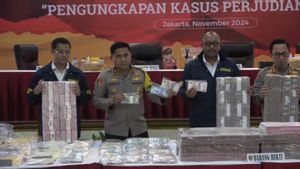JAKARTA - Chief Justice of the Supreme Court, Syarifuddin, admits that there is a disparity in sentencing as a result of the multi-interpreted articles in Law Number 35 of 2009 concerning Narcotics, particularly regarding criminal acts of illicit trafficking and narcotics abusers.
“Not infrequently, the application of these two articles is different, often confused with one another. The confusion of interpretations in these two articles illustrates the phenomenon of inconsistency in the application of the law which injures legal certainty," said Syarifuddin.
This statement was conveyed by Syarifuddin when giving a key speech at a research dissemination event entitled Disparities and Policies for Handling Narcotics Crime Cases in Indonesia which was broadcast on the YouTube channel IJRS TV, monitored from Jakarta, Tuesday, June 28, quoted by Antara.
The articles referred to by Syarifuddin are Articles 111 and 112 in the Narcotics Law which contain criminal provisions for someone who possesses or controls narcotics, as well as Article 127 which contains provisions regarding narcotics users.
"For example, if someone fulfills the element of narcotics abuse in Article 127 of the Narcotics Law, then automatically he has fulfilled the element of possessing or controlling narcotics in Article 111 or 112 of the Narcotics Law," said Syarifuddin.
The two articles carry very different criminal penalties. In Articles 111 and 112, the maximum imprisonment is 20 years, while in Article 127, the maximum imprisonment is 4 years for class I narcotics users.
Furthermore, Article 127 contains regulations if the user is proven to be a victim of narcotics abuse, the user is obliged to undergo medical rehabilitation and social rehabilitation.
"The two articles have far different criminal threats so that legal uncertainty ultimately leads to injustice," he said.
In order to overcome these problems, the Supreme Court has enacted the Circular Letter of the Supreme Court Number 3 of 2015 concerning the Implementation of the Formulas of the Results of the Plenary Meeting of the Supreme Court Chamber of 2015 as Guidelines for the Implementation of Duties for the Court.
The Circular allows judges to decide crimes under the minimum penalty as long as the legal facts at trial show that the defendant is a narcotics abuser.
"It's just that this solution has not completely solved the problem because the defendant is still proven to have committed Article 111 and Article 112 of the Narcotics Law so that the opportunity to impose rehabilitation is closed," he said.
This then results in disparity in sentencing or differences in the imposition of criminal penalties on cases that have similar characteristics, he explained.
"The disparity in sentencing is also contrary to the objectives of the law, namely certainty, expediency, and justice," said Syarifuddin.
The English, Chinese, Japanese, Arabic, and French versions are automatically generated by the AI. So there may still be inaccuracies in translating, please always see Indonesian as our main language. (system supported by DigitalSiber.id)













